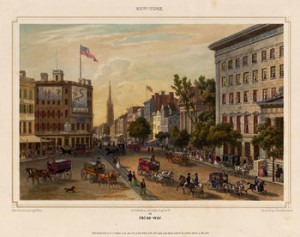America’s adventure with cities began in earnest during the four decades following 1820. There had of course been urban centers during the colonial and early national eras. But between 1820 and the onset of the Civil War, the proportion of the nation’s residents inhabiting communities of twenty-five hundred or more (the crude but conventional index of “urban”) jumped from about one in thirteen to one in five. Concentrated primarily in the North, the shift entailed natural reproduction of current city residents joined by the arrival of white rural folk searching for better (or at least different) opportunities. Especially in the North, however, it also entailed the presence of free blacks, of slave escapees from the South, and heavy infusions of newcomers from other countries. And with these heterogeneous demographic ingredients came other developments. Antebellum cities like Boston, New York, and Philadelphia were arenas of remarkable (albeit remarkably uneven) economic growth, of frequent social and cultural reconfigurations, of appreciable tension and conflict—and above all of incessant changefulness. Such cities might be worrisome. Often they were puzzling. But they had to be engaged by contemporary Americans. And crucial to how they were engaged was a large and highly diverse assemblage of pictorial representations we may style city views of the antebellum North.
Two framing factors should be born in mind in discussing these images. First, they existed within an overall outpouring of pictures. After all, the 1840s and 1850s were the birth time in America of photography and the implantation of literally millions of photographic graphics within the milieu. But equally, it was a time of major growth in non-photographic images. Precise statistics are not possible. But it’s evident that more picture makers (both native-born and immigrants) were working fulltime (both as free-lancers and as more or less steady employees of image-producing enterprises) to turn out graphics, which, together with imports from overseas, ensured rising numbers of pictures made without cameras. There were paintings, drawings, and prints—including under this last heading images extending from lithographs and woodcuts to various engravings. The full inventory of antebellum pictures encompassed a spectrum of sophistication, prices, and accessibility. And prints in particular existed as both free-standing artifacts and as illustrations garnishing increasingly large and variegated arrays of publications: venues that included thick assortments of books, pamphlets, and periodicals, from cheap to elegant.
Indeed, taking antebellum picture making as a whole, it’s evident that the upsurge of pictures surrounding antebellum northern city views even included representations of other places. Though substantially less abundant than their northern-focused counterparts (and consequently not under immediate review here), there were some images of contemporary southern communities. Then too, and more notably, there were pictures of the hinterland. Notwithstanding the tilts toward urbanization, most Americans, including most northern Americans, continued to live in the countryside. And the rural retained enormous material and cultural importance. Landscape pictures emerged in these years as a dominant registration of how this nation hosted unrivaled God-sanctioned expressions of nature (of nature become Nature), while genre images of rustic mores provided soothing visions of harmony and stability.
A second framework for the views of the antebellum urban North was the backstory of earlier images treating American towns and cities. As there had been urban settings before 1820, so there had been city views. During colonial years, maps (some sporting figurative cartouches) had now and again provided representational “plans” of larger communities. And during both colonial and early national periods, there were townscapes (typically sighted across waterfronts) and streetscapes (figs. 1 and 2), as well as pictures of particular buildings and incidents (from “mobs” to parades) sufficiently associated with urban communities to comprise engagements with city panoramas.
Moreover, by the early 1800s communities like Philadelphia and New York were drawing upon the rich European tradition of “street cry” imagery to produce graphic records of their own street vendors that amounted to a further significant version of city views (fig. 3).
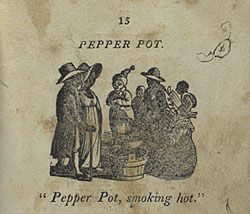
What were the goals behind these pre-1820 city views? Typically, these pictures sought to lay out information: to deploy facts about urban North America. Before the Revolution, however, city views were not uncommonly produced by Old World artists and aimed at Europeans skeptical that America even had cities of any note. Supplying information was thus at times combined with, and perhaps outweighed by, the goal of overcoming such doubts. And the images were consequently constructed less as rigorously accurate transcriptions of (say) Boston, New York, or Philadelphia than as loosely configured designations of some city. Accuracy grew more important in the years between 1783 and 1820. But city views crafted in this era often express other blendings, this time joining information giving with efforts to render their subjects interesting and amusing (via the street-cry imagery, for example) as well as—crucially—to deliver urban good news. The almost routine patriotism manifested by early national artists (not excepting the substantial roster entering the new nation from overseas) and used by them to gain acceptance in the early Republic, together with the ongoing belief that graphic arts should be inspirational and leavening (rather than critical and condemning)—all this fostered early national city views of a decidedly upbeat character. Specifically, such attitudes encouraged images that avoid depicting urban poverty and instead emphasize keys to urban prosperity—not just by showing prominent buildings and waterfront sightings of busy ships (as provincial images had now and again disclosed) but increasingly by stressing wealthy homes and, preeminently, bustling streets. Hence Francis Guy’s well-known painting of New York’s Tontine Coffee House (1797) gives as much attention to the hectically converging thoroughfares fronting the structure as to the coffee house itself (fig. 4).
Such, then, was the context for antebellum views of northern cities. And at one level these post-1820 pictures can be taken as simply fitting within this framework. Certainly they continued the formats already in play, for they were often configured as townscapes, streetscapes, and street cries, as pictures of incidents and of individual buildings. At the same time, these images demonstrably reflected the contemporary surge of graphics, for they made use of all the techniques of picture making available in the antebellum era, from painting to drawing, from photography and lithography to all manner of engraving. And produced through these techniques, antebellum city views likewise paralleled the broad range of formal refinement (and cost) characterizing pictures generally in these decades. Again, moreover, prints especially exemplified the spread. For antebellum city views rendered as prints ran the gamut from highly skilled images to less technically impressive lithographs and fairly crude woodcuts, from stand-alone images to pictures tucked into volumes and journals, both pricey and cheap (and including the newly popular digests known as city guides).

In several notable respects, however, antebellum city views actually went in new directions. Thus, alongside familiar configurations, we now find more fully developed genre treatments, such as images that go beyond street cries to depictions of so called street figures (fig. 5). So too, we find townscapes constructed as panoramic or hyper-elevated bird’s-eye views (fig. 6). And treatments of single buildings (and sometimes their surrounding streets) are now often cast as trade cards. Occasionally recycled into newspaper notices but for the most part published as single sheets meant to be posted publicly (sometimes in splendid color) or distributed free to the public, trade cards were advertisements that were commissioned by stores and manufactories and that generally centered around detailed pictorial representations of the sponsoring businesses.
When these establishments were located in urban settings, and the representations focused on the buildings housing the businesses, the cards became, willy-nilly, important installments of antebellum city views.
Ultimately, however, the most trenchant shift in antebellum city views—and the one I’ll focus on for the remainder of this discussion—had to do with their purpose: with their cultural “work.” To be sure, earlier intentions, and mixings of intentions, did not disappear. There was a drive for information giving and for accuracy (as demonstrated in the painstaking draftsmanship of bird’s-eye views), for amusement (as evident in both the ongoing city cries and the new street figures), and for positive messages (as shown in renderings of crowded, in fact increasingly crowded, thoroughfares). Yet shifts in the goals of these images are no less manifest. There are instances, for example, when the push for precision clearly overcomes the priority of inspiration. For the first time city views start to examine poor neighborhoods, and as a result we begin to get judgments of cities that are cautionary—even alarmist—as well as upbeat (fig. 7). But pictorial registrations of urban destitution were hardly the only realignment of purpose in city views. In deeper, more systemic ways, the most trenchant alteration in the goal of these pictures seems to have been a heightened drive to explain.

Exactly because antebellum northern cities could be worrisome and puzzling, exactly because they were so incontestably changeful, and perhaps also because, as a result, urban vistas departed so dramatically from the iconic, reassuring visions of rural America—for such reasons, there was a generalized desire, indeed a broadly felt necessity, to develop firmer understandings of the urban milieu. And in that light, it’s not hard—on the contrary it makes considerable sense—to read antebellum city views as being especially about explicating the panoramas they displayed: as essaying not just to provide informative facts but to show how these facts constituted patterns and processes of urban life; as striving not just to deliver amusing vignettes or pass judgments (whether positive or negative) but to demonstrate how cities existed and how they worked. This is not to argue that pictures of rural America did not also embrace forays into explaining what was happening outside cities. Nor is it to deny that explanatory tropes used by city views do not show up elsewhere in the era’s graphic literature. But it is to suggest that antebellum city views can be reasonably seen as aiming, more centrally than ever, to comprehend urban terrains.
Thus, while overhead perspectives were hardly unprecedented in the history of graphic representations, the key function (and appeal) of panoramic and bird’s-eye city views in this period likely turned on their ability to make the total shape of urban settings readily comprehensible. And the individual structures often featured along the borders of bird’s-eye views (as in figure 6) would only have supplemented this legibility by joining particulars to the whole: by giving viewers the added leverage of understanding cities as both totalities and discrete elements. Similarly, we should not ignore the explanatory force of accuracy in these images. Now it is true that antebellum city views were not entirely devoid of intentional distortions; occasionally they privileged compositional balance or anticipated new construction that departed from the reality of a given moment. And it’s true as well that the accuracy they did exhibit in many ways simply continued the advancing commitment to truthful city views commenced in early national times. Still, the overall devotion to precision apparent in post-1820 pictures of cities—certainly in photographs but in non-photographic graphics also—held special meaning. Given the continuing rhythms of change sweeping through northern cities, the representational reliability of most antebellum urban images may well have provided those regarding these graphics with a pleasing cognitive anchor: the knowledge that amidst all the transitions, this building or that street looked just so. Such knowledge, in turn, could well have carried the implicit proposition that accurately depicting a building or street at a given pictorial moment would help explain the often disconcerting texture of the urban milieu.
More concretely, views of northern cities in these years offer explanatory guides to components of the urban economy. Trade cards were marvelously instructive along these lines. The interior and cutaway views they sometimes offer of manufacturing establishments, for example, go some way to displaying step-by-step narratives of production (fig. 8). And even trade cards that fix on the outside of businesses would almost certainly have carried instructive implications. For one thing, they likely provided clues to help urbanites locate various establishments. At a time when (reflecting the fluidity of urban centers) stores and workshops frequently changed locations within a city, pictures that (reflecting the accuracy of most antebellum city views) displayed recognizable portraits of business exteriors could only have facilitated locating a given store or workshop. Added to this, trade cards presenting outside views of stores now and then end up both illustrating what was for sale and providing primers in how to buy. The former project is often accomplished through careful inclusions of shop signs. The latter explanatory purpose is achieved by illustrating individuals moving through sequenced steps of purchase. Potential customers are sometimes shown engaged in the newly surfacing practice of window shopping or in the longer-standing tradition of examining goods piled on sidewalks, the pictured figures in effect initiating the process of buying by familiarizing themselves with the merchandise available. But then, using the vehicle of windows and open doorways, exterior views of stores also reveal the next phase, the stage involving individuals moving inside retail spaces to interact with clerks and actually acquire an item (fig. 9).
Following similarly concrete routes, the images we’re exploring make further explanatory use of the city dwellers they delimit. Thus, they mobilize the emblems of clothing and observable activities to document the cohabitation within cities of affluent folk and working people. And in doing this much they quietly suggest that urban environments are to be understood—indeed, can only be understood—in terms of both better sorts and laboring folk. But it is the case, too, that lesser-ranked figures are more present in post-1820 urban views than in earlier pictures of American cities, so that antebellum urban imagery softly advances the contention-registered throughout antebellum culture—that the visual presence of working people was becoming more established in America and more vital to understanding many facets of the Republic’s existence. Added to this, the presence of pictured figures of recognizably different standing in urban venues often serves to explain at least some of the complex choreography among socioeconomic strata in cities of the antebellum North. For, taken as a whole, the pictures reveal higher and lower ranks at once interacting and yet often remaining apart—salient features of what class meant in these places.
Another way figures in urban views were harnessed to an explanatory purpose was in their formulation as types. The urban genre imagery of the period, and most notably the graphics of street figures, took heavy advantage of tendencies in antebellum representations to situate individuals within groupings that go beyond class to encompass racial, ethnic, and even regional niches. Or (as evident in figure 5, above) even subniches: the poor, pathetic, waif-like street sweeper, for example, or the slightly menacing (because slightly weasily-appearing) youthful hawker of kindling. In any event, the result was that urban views deposit figures into easily comprehensible categories that, in company with class designations, enabled viewers of the views to more easily chart—and thus understand—the often confusing medleys of individuals encountered in places like Boston, New York, and Philadelphia.
The final explanatory dimension of antebellum city views we need to ponder relates to their observational strategies. And what is particularly important to consider here are the watching figures positioned inside the images. These individuals signal modes by which Americans actually regarded city settings, modes the views themselves seem on some level to take on as their points of view.
Who were these watchers? Occasionally they were working people. But more frequently, and rather more defining of the perspectives city views themselves unfurled, they were figures of standing or authority (or both). So there are the instances of window shopping, with the window shoppers usually flagged as more or less genteel. And if we look closely at streetscapes, we can perhaps also find signs of the watchful promenades the upper ranks had begun undertaking in these years, coupled with the related custom of urban bystanding through which pedestrians (again usually upper-ranked) pause to observe street scenes or curbside events (fig. 10). And by the same token we can spot references to (or at least hints of) individuals engaged in oversight. Particularly apparent in depictions of ongoing labor (in the workrooms illustrated by figure 8, for example), suggestions of supervision grow generally more frequent in antebellum city views. And this was because such references in fact point to—were in fact part of—a broad reorientation in the nation’s post-1820 visual culture. Linked to shifts reaching from aesthetics to mounting controversies over slavery (and its systems of oversight) and connected to growth of reformative supervision on one side and to crescendos of bourgeois modesty (and more abstractly to the trajectories of rationality Michel Foucault has ascribed to Western modernity) on the other, the alteration in America’s visual culture in play here took different shapes. But as we come upon it in antebellum city views—as we can perhaps detect its imprint extending tangentially even beyond workplace supervisors to other regard-wielding figures in these images—the core nature of the change is clear enough. Simply put, in contrast to provincial or early national times, the act of regarding was becoming more expressive of elevated standing and power than the experience of being regarded.
As I have suggested, antebellum city views can be interpreted as adopting for themselves the stances of their observing protagonists, so that their efforts to explain in some measure unfold through the eyes of their own watchers. It is of course quite true that post-1820 city views were built on received conventions of pictorial viewpoints. And it is true as well that they appropriated angles of regard (like their panoramic and bird’s-eye standpoints) unrelated to their roster of interior observers. Still, it seems possible to inscribe into many of these images an outlook cast as middling or upper ranked, as carrying the distanced flavor of window shopping, bystanding, and promenading, and as touched by the authority exemplified by supervision. Indeed, it seems possible to go yet further and infer from these images tendencies to equate such an outlook with an assumed viewership. For while their divergent forms and prices make it all but certain a wide mix of people saw these images, it is not a large reach to understand views of antebellum northern cities as projecting an audience resembling the bulk of the viewers they picture.
There was, though, a complication to this fusion of pictured watchers, pictorial perspectives, and external viewerships. It was the complication of the flâneur. Long gestating in Europe, the flâneur surfaced in the antebellum Republic as another antebellum social type. Construed as typically male, usually—though admittedly not always—of upper rank, flâneurs were reckoned to traverse urban—not rural—territories. And while thought to occasionally respond to what they saw with interpretive (even intricately imaginative) narratives, flâneurs were more often registered as figures who only looked on, who surpassed other city observers by doing nothing but observing and who, moreover, observed not merely with distance but with thoroughly self-satisfied disengagement. Appropriated by journalists and by authors as different as Poe and Whitman, the flâneur posture was also present in city views, the persona characteristically presented as a stylish gent slouched watchfully against a lamppost (fig. 11).

But the flâneur raised problems. Inasmuch as he truly only watched, he was by definition unproductive. And in a republic dedicated to notions of virtue resolutely tied to productivity, he was thus anomalous—or worse. He was an “aristocratic” parasite, a potentially malevolent “lounger” or “loafer.” Other difficulties attended his role in city views. To start with, his determinedly total disengagement conflicted with the interest these images demonstrated in deploying judgments—by this time both negative and positive—about the cities they portrayed. Every bit as significant, however, the flâneur’s decided aloofness confined him mainly to surface impressions and, consequently, to an explanatory perspective on of urban life that was actually becoming suspect. For the fact is that in multiple and complicated ways—in ways we can only allude to in this essay—fair portions of antebellum Americans were finding outer (i.e., surface) manifestations of reality increasingly unreliable. Concern was deepening, for example, that physical self-presentations might be faked, that expensive-looking clothes might be only cheap ready-made knock-offs, that banknotes might be counterfeit, and that the most readily ascertainable aspects of cities might not tell the full story. And against that background, the flâneur’s surface-clinging viewpoint could well seem problematic.
Hence arose corrective responses. In the culture as a whole, there were efforts to assess external forms critically. From phrenology (which developed into an extraordinarily popular “scientific” tactic for connecting people’s outer physiologies with their inner temperaments), to calls for intense scrutiny of clothes (to distinguish tailor-made from off-the-rack and thus to determine an outfit’s underlying meaning), and on further to counterfeit detectors (for identifying false money)—making use of such techniques and technologies, good numbers of Americans set about to take account of what was without but then probe what lay within. Nor were cities excluded from this approach. Journalistic exposés and “Mysteries-of-the-City” stories sought to lay bare the underlying “truths” of major metropolises. And of direct relevance to our considerations, city views hosted their own penetrations of surface impressions. Which is to say, their quest to explain ultimately led these images to provide counterbalancings to the flâneur’s form of onlooking tout court, to offset the flâneur’s emphatically self-contented regard of mere surfaces. And so, while they might contain flâneurs, pictures of antebellum northern cities also, and more frequently, include images (some of them coordinated with journalistic pieces) expressly calculated to reveal the underlying (and often unsettling) portions of antebellum urban situations (fig. 12). Indeed, in light of this investigatory impulse, even images we remarked upon earlier take on new connotations. The confluence of trade cards that illuminate both exteriors and interiors of urban enterprises, for example, now acquires the feel of an aggregate perspective, rooted in joining the without to the within. And similarly, the coexistence of pictures glossing Broadway and New York’s notorious Five Points slum now takes on the sense of a composite viewpoint organized around treating both what the city wanted to display—its surface glitter, as it were—and the truth of its seamy underside.
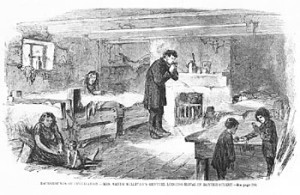
To be sure, this tilt toward the darker underside did not appeal universally. Concerned to shield white society from criticisms, the South was relatively unreceptive to diggings beneath surfaces, with the result that views of southern cities, even those mixing exteriors and interiors, lacked the powerful investigatory drive present in the North. And likewise, endeavoring to learn what surface appearances might cover did not always make sense to working people. Antebellum lesser folk were by and large alert to the utility of masks, pretense, and outright dissimulation in dealing with difficult (and often patently unfair) economic pressures. And they were thus by and large open to making (and manipulating) their way along the byways of outer appearances. All of this ensured the regional flavoring of northern city views. And it also ensured that even when they rejected the flâneur, the outlook of these pictures was characteristically not from the bottom up but remained (in accordance with most of the more acceptable observers they depicted) aligned with middling or upper strata.
This brief survey scarcely exhausts all the ways northern cities were viewed in this period or all the ways viewing transpired within these communities. But it is perhaps sufficient to mark the pivotal part city views played in delimiting—and more generally engaging—key urban panoramas rising up in America between 1820 and 1861.
Further Reading:
Because this article roams across a variety of topics, the following is simply a sample of volumes that include images, and discussions of images, bearing on antebellum northern cities: Gloria Gilda Deák, Picturing America, 1497-1899: Prints, Maps, and Drawings Bearing on the New World Discoveries and on the Development of the Territory that is Now the United States (Princeton, 1988). E. McSherry Fowble, Two Centuries of Prints in America, 1680-1880: A Selective Catalogue of the Winterthur Museum Collection (Charlottesville, Va., 1987). Peter B. Hales, Silver Cities: The Photography of American Urbanization, 1839-1915 (Philadelphia, 1984). John A. Kouwenhoven, Columbia Historical Portrait of New York: An Essay in Graphic History in Honor of the Tricentennial of New York City and the Bicentennial of Columbia University (New York, 1953). John W. Rep, Lithographs of Towns and Cities in the United States and Canada, Notes on the Artists and Publishers, and a Union Catalog of their Work, 1825-1925 (Columbia, Mo., 1985). Nicolas B. Wainwright, Philadelphia in the Romantic Age of Lithography (Philadelphia, 1958).
This article originally appeared in issue 7.3 (April, 2007).
Jonathan Prude, a student of nineteenth-century American social, labor, and cultural history, teaches at Emory University. He is currently completing a book on The Appearance of Class; The Visual Presence of American Working People from the Revolution to World War I.



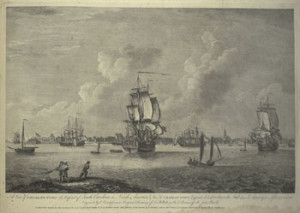
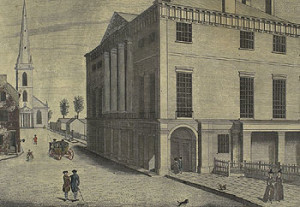


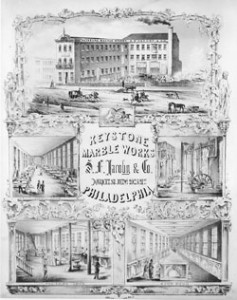
![Fig. 9. W. H. Rease. [Joseph Feinour's Stove and Hardware Stores]. (Philadelphia, ca. 1845). Courtesy of the Library Company of Philadelphia.](https://commonplace.online/wp-content/uploads/2016/01/7.3.Prude_.9-300x195.jpg)
